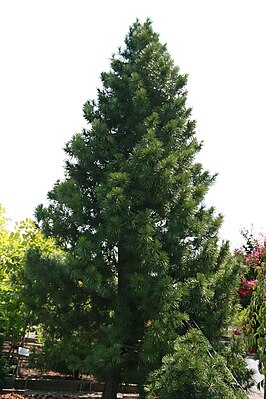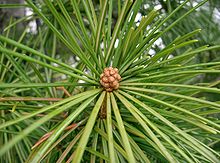Umbrella fir
| Umbrella fir | ||||||||||||
|---|---|---|---|---|---|---|---|---|---|---|---|---|

Umbrella fir ( Sciadopitys verticillata ) |
||||||||||||
| Systematics | ||||||||||||
|
||||||||||||
| Scientific name of the family | ||||||||||||
| Sciadopityaceae | ||||||||||||
| Luerss. | ||||||||||||
| Scientific name of the genus | ||||||||||||
| Sciadopitys | ||||||||||||
| Sieve. & Zucc. | ||||||||||||
| Scientific name of the species | ||||||||||||
| Sciadopitys verticillata | ||||||||||||
| ( Thunb. ) Siebold & Zucc. |
The umbrella fir ( Sciadopitys verticillata ) is the only species of the monotypical plant genus Sciadopitys and at the same time the only species of the umbrella fir family (Sciadopityaceae) within the order of the pine-like (Coniferales).
description

Appearance
The umbrella fir grows as an evergreen tree that reaches heights of 20 to 30, rarely up to 40 meters and chest height diameters of 1 to rarely 3 meters. The largest living specimen grows at the Jinguji Temple in Koaza Himejitani Aza Ishikawa in the city of Nodagawa in the Japanese prefecture of Kyoto ; it has a stature height of 27 meters and a circumference of 4.1 meters. They grow slowly, both single and multi-stemmed and are richly branched.
The bark is thick and reddish-brown. The bark of the branches is orange-brown.
The buds are egg-shaped with a length of 3 to 4 millimeters. The branches, which are more or less spirally arranged at an angle of about 90 °, are usually short. The seedlings have two seed leaves ( cotyledons ).
leaves
There are two types of leaves: On the one hand, scaly, triangular leaves on the stem; they are brown and only 1 to 6 millimeters in size. On the other hand, the photosynthetically active foliage leaves , they are linear and flat, shaped roughly like pine needles, but they have a different internal structure because they develop when two leaves grow together. These needle-shaped leaves sit in groups of ten to thirty on short or long shoots . They are 6 to 13 inches long, 2 to 3 millimeters wide and 1 millimeter thick; they stay on the tree for three to four years.
Flowers, cones and seeds
The umbrella fir is single-sexed ( monoecious ). The male, cone-shaped flowers that stand together at the ends of the branches are 6 to 12 millimeters long and have a spiral structure with many microsporophylls . The spherical pollen have no air sacs. The female cones standing on short stalks are narrowly ovate and initially green. The spirally arranged cover scales have a thin, curved edge and almost envelop the triangular seed scales. The ripe cones are then dark brown, easily fragile, 4.5 to 10 inches long and 3.5 to 6.5 inches wide when open. Five to nine seeds are formed per seed scale.
The seeds are ripe 18 to 20 months after pollination . The flat, orange-brown seeds are 8 to 12 millimeters long and about 8 millimeters in diameter, flattened, ovoid. They have a narrow wing.
The number of chromosomes is 2n = 20.
Occurrence and evolutionary history
The umbrella fir occurs only on the Japanese islands of southern Honshū , Kyūshū and Shikoku . It thrives in the mixed forests of the subtropical cloud forests at medium altitudes of 500 to 1000 meters with high levels of precipitation and high humidity.
The Sciadopityaceae family used to have a wide distribution with many species. Fossils are widespread and have been documented since the Upper Triassic (Rhaetian). This family had its main development in the Lower Cretaceous . Fossils have also been found in Europe, where some species were common in the Tertiary . From the results of a 2009 study of Baltic amber using infrared spectroscopy and other methods, there was profound evidence of the possibility that an extinct species from this family closely related to the umbrella fir might be the main producer of the resin of this Eocene amber.
Systematics
It was first published in 1784 under the name ( Basionym ) Taxus verticillata by Carl Peter Thunberg in Johan Andreas Murray : Systema Vegetabilium. 14th edition, p. 895. The genus Sciadopitys was established in 1842 by Philipp Franz von Siebold and Joseph Gerhard Zuccarini in the work Flora Japonica , Volume 2, Page 1 with the type species Sciadopitys verticillata . The botanical generic name Sciadopitys is derived from the Greek words skiás , skiádos σκιάς for "umbrella" and pítys πίτυς for "spruce" or "pine". Other synonyms for Sciadopitys verticillata (Thunb.) Siebold & Zucc. are: Podocarpus verticillatus (Thunb.) Wall. ex Steud. , Pinus verticillata (Thunb.) Siebold .
The Sciadopityaceae family was set up in 1877 by Christian Luerssen in Grundzüge der Botanik , Leipzig. A synonym for the Sciadopityaceae family is Taxodiaceae subfam. Sciadopityoideae Silba , so it was classified as part of the Taxodiaceae family . Steven J. Brunsfeld et al. showed 1994 in Phylogenetic relationships among the genera of Taxodiaceae and Cupressaceae: evidence from rbcL sequences. In: Systematic Botany , Volume 19, Issue 2 that it is a separate family.
use
The umbrella fir is used worldwide as an ornamental plant for parks and gardens. It is also planted as a forest tree for wood production. Since this species grows slowly, Japan has started to replace it in forests with faster growing species such as Cryptomeria japonica .
The spicy, fragrant, soft, elastic wood is very resistant in water and is therefore used in boat building. An oil is obtained that is used as a varnish and dye. The bark is used for sealing.
Common names
The Japanese name is Kōya-Maki ( 高 野 槙 or 高 野 槇 , literally: Kōya - stone slice ). The umbrella fir is one of the "Five Trees of Kiso " which were placed under nature protection in the Owari fief in 1708 .
swell
- Christopher J. Earle: Sciadopitys verticillata. In: The Gymnosperm Database. March 1, 2019, accessed May 8, 2019 .
- Liguo Fu, Yong-fu Yu, Aljos Farjon: Sciadopityoideae Luerssen , p. 53 - online with the same text as the printed work , In: Wu Zheng-yi, Peter H. Raven (ed.): Flora of China. Volume 4: Cycadaceae through Fagaceae. Science Press and Missouri Botanical Garden Press, Beijing and St. Louis, 1999, ISBN 0-915279-70-3 .
Individual evidence
- ↑ a b c d e f Christopher J. Earle: Sciadopitys verticillata. In: The Gymnosperm Database. March 1, 2019, accessed May 8, 2019 .
- ^ Umbrella fir at Tropicos.org. In: IPCN Chromosome Reports . Missouri Botanical Garden, St. Louis
- ↑ Liguo Fu, Yong-fu Yu, Aljos Farjon: Sciadopityoideae Luerssen , p. 53 - online with the same text as the printed work , In: Wu Zheng-yi, Peter H. Raven (ed.): Flora of China. Volume 4: Cycadaceae through Fagaceae. Science Press and Missouri Botanical Garden Press, Beijing and St. Louis, 1999, ISBN 0-915279-70-3 .
- ^ The Sciadopityoideae family on the AP website .
- ↑ Alexander P. Wolfe et al .: A new proposal concerning the botanical origin of Baltic amber. In: Proceeding in the Royal Society - Biological Science. Volume 276, London 2009.
- ^ Umbrella fir at Tropicos.org. Missouri Botanical Garden, St. Louis, Retrieved May 8, 2019.
- ↑ Steven J. Brunsfeld, Pamela E. Soltis, Douglas E. Soltis, Paul A. Gedek, Christopher J. Quinn, Darren D. Strenge, Tom A. Ranker: Phylogenetic relationships among the genera of Taxodiaceae and Cupressaceae: evidence from rbcL sequences . In: Systematic Botany. Volume 19, Issue 2, 1994, pp. 253-262.
- ^ Sciadopitys verticillata at Plants For A Future
- ↑ 木 曽 三 川 川 の 流 れ と 歴 史 の 歩 み 【木 曽 川 ・ 長 良 川 ・ 揖 斐川】 . 14. 木 曽 五 木 . (No longer available online.) In: 古 地理 調査 . Kokudo Chiriin , archived from the original on January 21, 2013 ; Retrieved December 19, 2012 (Japanese). Info: The archive link was inserted automatically and has not yet been checked. Please check the original and archive link according to the instructions and then remove this notice.
Web links
- Sciadopitys verticillata in the endangered Red List species the IUCN 2006. Posted by: Conifer Specialist Group, 1998. Retrieved on 11 May, 2006.
- Sciadopityaceae. Kew Royal Botanic Gardens, accessed October 20, 2011 .





